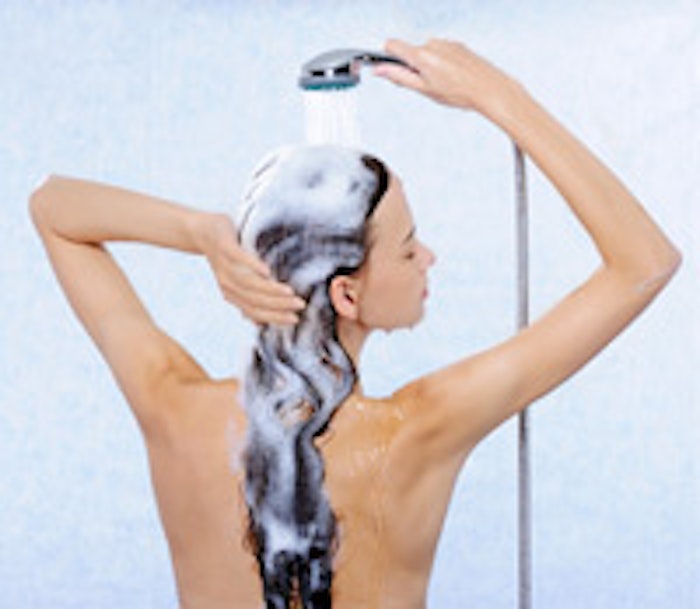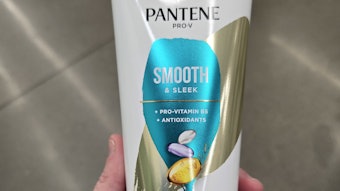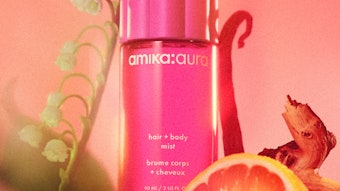
Abstract: The positive effects of glycolic acid for skin care are well-documented; however, similar studies in hair care are not. DuPont and the Textile Research Institute (TRI) in Princeton, New Jersey, conducted several studies, described here, to investigate the potential role of glycolic acid in hair care.
Glycolic acid is a carboxylic acid with alcohol functionality. It is the simplest alpha hydroxy acid (AHA) and smallest of the fruit acids. Well-known for its use in skin care, glycolic acid has been shown to normalize the process of keratinization and therefore improve the look of the skin. Specifically, it can re-adjust moisture in the epidermis allowing for smoother, softer, more radiant skin. Although the positive effects of glycolic acid for skin care are well-documented, similar research for effects in hair care are not. Therefore, DuPont investigated the potential role of glycolic acid in hair care. The present paper discusses tests conducted at DuPont and the Textile Research Institute (TRI) in Princeton, New Jersey.
Experiments
Four types of experiments were conducted based on key attributes consumers desire to evaluate glycolic acid in hair care applications. These parameters included manageability, strength, protection and conditioning. Differential scanning calorimetry (DSC) and tensile strength testing were conducted at DuPont while repeated brushing and two separate wet combing studies were conducted at TRI/Princeton.
Differential Scanning Calorimetry (DSC) Test
To examine the denaturation of keratin in hair, high-pressure DSC was performed to determine the temperatures at which water separates from keratin and keratin denatures, as described by Wortmann and Deutz.1 A total of 10 hair tresses—five healthy and five bleached samples—were used. One healthy and one bleached hair sample were treated with stearyl alcohol and water as a control. Another healthy sample and bleached sample each was treated with a 5% DuPont™ Glypure® solution. Finally, three each of the healthy and bleached samples were each treated with either Dow Corning 2-8194 Microemulsion, Bioplex Cetylsil S or Incroquat Behenyl TMS. All samples were treated for 5 min.
Healthy hair treated with DuPont™ Glypure® tolerated a 6.5°C increase in temperature, and bleached hair tolerated a 2.5°C increase in temperature in the same product. Hair samples treated with the other ingredients showed little, none or a slight decrease in temperature tolerance. This finding reveals that hair, both healthy and bleached, is able to hold moisture at higher temperatures for longer durations when treated with DuPont™ Glypure®.
Tensile Strength
Researchers also conducted a tensile strength experiments on both healthy and bleached tresses based on parameters discussed by Robbins.2 A total of 10 hair tresses—five healthy and five bleached samples—were tested in the same manner and with the same materials as described above. All samples were treated for 5 min. The hair tresses were tested with an Instron® Tensile Testing Instrument at 6-inch lengths using a pull rate of 0.25 cm/min. The testing environment was controlled at 70°F with 65% relative humidity.
Both the healthy hair and bleached hair samples showed benefits from being treated with each of the four ingredients tested, including the DuPont™ Glypure® solution. These results show an increase in both tenacity at break and toughness, proving that hair, both healthy and bleached, is stronger and more resistant to breakage after treatment with DuPont™ Glypure®.
Repeated Brushing
A repeated brushing experiment was initiated first by bleaching four hair tresses. One tress was then treated for 1 min with a DuPont™ Glypure® starting point formulation; another was treated with a bargain brand hair conditioner for 1 min; another with a high-quality brand hair conditioner for 1 min; and the remaining hair tress was left untreated as a control. The tresses were brushed 1,000 times using a custom-made repeating brushing device. After brushing, the broken fibers were counted.
The hair sample treated with the DuPont™ Glypure® formulation showed a significant improvement over the untreated hair sample and performed as well or better than the hair sample treated with the high-quality brand. The data indicates that DuPont™ Glypure® provides lubrication to the hair, resulting in less friction and entanglement during brushing, which leads to significant reduction in breakage and improved manageability. This lubrication also benefits the scalp, reducing flaking and dryness.
Wet Combing
Two wet-combing experiments were conducted in accordance with the method previously described by Garcia.3 In the first experiment, researchers tested two versions of the same hair conditioning treatment—one with DuPont™ Glypure® and one without—to determine the effect of glycolic acid. For the version not including DuPont™ Glypure®, citric acid was added to obtain a pH level of 4.0.
Similarly, in a second experiment, researchers compared the same DuPont™ Glypure® hair conditioning treatment to a bargain brand hair conditioner and a high-quality brand hair conditioner.
In the first of the experiments, researchers first bleached three hair tresses and treated one with the DuPont™ Glypure® formulation for 1 min. Another tress was treated for 1 min with the same conditioning treatment but excluding the DuPont™ Glypure® product. The remaining hair tress was left untreated as a control. The tresses were then subjected to wet combing per the test method cited. The amount of frictional force required to comb through the tresses was measured.
The amount of frictional force required to comb through the treated hair samples was significantly less than that required to comb through the untreated sample, proving the positive lubricity effect of the treatment based on DuPont™ Glypure®. This experiment further substantiates that the treatment containing DuPont™ Glypure® showed a significantly superior effect, compared to the same treatment without the ingredient. This confirms that DuPont™ Glypure® makes hair more manageable and easier to style.
In the second wet-combing experiment researchers again began by bleaching four hair tresses. Then, one was treated for 1 min with a treatment based on DuPont™ Glypure® while another was treated with a bargain brand hair conditioner for 1 min. A third was treated with a high-quality brand hair conditioner for 1 min and the remaining hair tress was left untreated as a control.
The tresses were again subjected to wet combing per the test method cited. The amount of frictional force required to comb through the tresses was measured. The sample treated with the hair conditioning treatment based on DuPont™ Glypure® showed a significant improvement over the untreated hair sample and performed almost as well as the hair sample treated with the high-quality brand, reducing the frictional force needed to comb the hair. Reducing the frictional force makes hair easier to comb and more manageable—two important attributes for consumers.
Conclusion
Glycolic acid is a popular antiaging active that has been used for years in skin care applications. However, results from the present tests also indicate that glycolic acid can be used deliver important benefits to hair—enhancing the protection and manageability of hair by conditioning, moisturizing, strengthening and preventing breakage, in both healthy and bleached hair. Adding glycolic acid to hair care formulations enables products to impart lubricity to hair, resulting in less friction and entanglement during combing and brushing, and making hair more manageable, easier to style and significantly less prone to breakage.
Hair care products with glycolic acid also strengthen hair and help to maintain moisture at higher temperatures for longer times, better protecting hair against the use of high temperature styling appliances. The data from these experiments clearly shows that both healthy hair and bleached hair can benefit from the multiple positive effects that DuPont™ Glypure® delivers in hair care product formulations.
Click here to access the full DuPont™ Glypure® glycolic acid hair care white paper.
References
- Wortmann, F.J., et al. Characterizing Keratins Using High-Pressure Differential Scanning Calorimetry (HPDSC). Journal of Applied Polymer Science 48:137-150; 1993.
- Robbins, Clarence R. Chemical and Physical Behavior of Human Hair (Fourth Edition), pages 2, 25-50, 82 and 388; 2002.
- Garcia, M.L., Diaz, J. Combability Measurements on Hair. Journal of the Society of Cosmetic Chemists 27: 379-398; 1976.
Supplemental References
- Pharmaceutical Compositions and Methods for Managing Scalp Conditions (Murad, WO 00/06144).
- Kempers M.D., Steven et al. An Evaluation of the Effect of an Alpha Hydroxy Acid-Blend Skin Cream in the Cosmetic Improvement of Symptoms of Moderate to Severe Xerosis, Epidermolytic Hyperkeratosis, and Ichthyosis. Therapeutics for the Clinician 61:347-350; 1998.
- Van Scott M.D., J. and Ruey J. Yu, PhD., O.M.D. Alpha Hydroxy Acids: Science and Therapeutic Use. A supplement to Cosmetic Dermatology, October 1994.
- Composition for Treatment and Care of Hair and Scalp (Onitsuka et al. US Patent 6,086,861) (KAO).
- Methods for Managing Scalp Conditions (Murad. US Patent 6,515,007).
The information set forth herein is furnished free of charge and based on technical data that DuPont believes to be reliable. It is intended for use by persons having technical skill, at their own risk. DuPont makes no warranties, expressed or implied, including a warranty of fitness for a particular purpose and assumes no liability in connection with any use of this information. Nothing herein is to be taken as a license to operate under any existing patents other than those specifically described herein. Always read the label, license and product information before use.
Copyright © 2009 DuPont. The DuPont Oval Logo, DuPont™, The miracles of science™, and Glypure® are trademarks or registered trademarks of E.I. du Pont de Nemours and Company or its affiliates. All rights reserved.
Disclaimer:
The above paid-for content was produced by and posted on behalf of the Sponsor. Content provided is generated solely by the Sponsor or its affiliates, and it is the Sponsor’s responsibility for the accuracy, completeness and validity of all information included. Cosmetics & Toiletries takes steps to ensure that you will not confuse sponsored content with content produced by Cosmetics & Toiletries and governed by its editorial policy.










